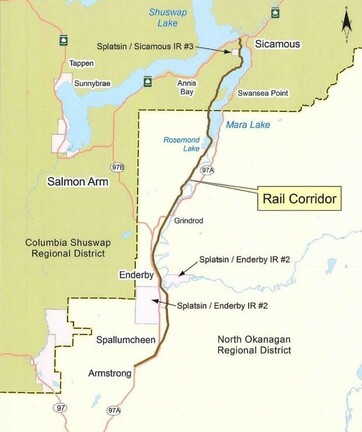
Shuswap North Okanagan Rail Trail
Recently, information has been shared about the financial impact of the Shuswap North Okanagan Rail Trail Project. The Rail Trail is a regional initiative to construct a 50km non-motorized greenway trail for walking and cycling between Sicamous and Armstrong.
The District of Sicamous is presenting the following financial information for clarity.
Who owns the Rail Trail?
The Splatsin te Secwépemc, the Columbia Shuswap Regional District (CSRD), and the Regional District of North Okanagan (RDNO).
- The Splatsin te Secwépemc contributed 7km of previously acquired trail.
- The CSRD and RDNO purchased 43km of trail.
The Rail Trail dates to 2015, when a letter of understanding was signed to demonstrate the regional commitment to work together on the initiative.
How was the Rail Trail land purchase funded?
The CSRD and RDNO purchased 43km of trail from CP Rail in 2018. The $6.5 million purchase was equally divided between Provincial grant funding, the CSRD and the RDNO.
The total cost for the CSRD to cover its 50% contribution was $2.17 million funded the following ways:
- A $250,000 contribution from the Sicamous/Area ‘E’ (Swansea Point/Malakwa) Economic Opportunity Fund;
- A $250,000 contribution from the Revelstoke/Area ‘B’ (Revelstoke Rural - Trout Lake and Galena Bay) Economic Opportunity Fund; and
- $1,838,384 financed through long-term borrowing over 25 years.
In 2017, the CSRD received electoral approval for the long-term borrowing through an Alternate Approval Process. With approvals from the electors and B.C.'s Inspector of Municipalities, the Rail Corridor Trail Loan Authorization Bylaw No. 5756 was adopted.
Who pays for the Rail Trail?
The CSRD, the RDNO and Splatsin te Secwépemc.
Capital Costs
Capital costs are split 50/50 between the CSRD and RDNO depending on the grant and funding mechanisms in place.
For example, in 2021, the CSRD and Splatsin te Secwépemc received a $500,000 BC Active Transportation Grant for the Rail Trail from Sicamous to Mara. Sicamous and Area E (Swansea Point and Malakwa) complemented this funding with a $232,455 contribution from the Sicamous/Area ‘E’ Economic Opportunity Fund.
Maintenance Costs
The costs to maintain the Rail Trail are split 46% CSRD, 46% RDNO and 8% Splatsin te Secwépemc.
Are there other funding mechanisms in place?
Fundraising strategies including joint applications for grant funding and partnering with fundraising groups. The Rail Trail initiative has received several large donations in recent years. In 2023, the Rotary Club of Salmon Arm provided a $10,000 donation, in 2022 SASCU donated $50,000 and in 2021 Askew’s Foods donated $100,000. Fundraising events are hosted, and the public can make individual donations.
How did the CSRD decide who participates and pays for the Rail Trail service?
To offer a service, a regional district must do so by bylaw. In 2017, Rail Corridor Trail Service Establishment Bylaw No. 5755 was adopted. This bylaw identifies who participates in the service and how the service costs are split between the participants.
Service Boundary Determination
The Rail Trail Service Boundary was created to mirror the Shuswap Tourism Service Area Boundary. Participants include the City of Salmon Arm, District of Sicamous, Electoral Area E, Electoral Area D, Electoral Area C and Electoral Area F.
Cost Breakdown Determination
The cost allocation between CSRD participants was determined by considering the tax base of the jurisdictions and their proximity to the trail. Participants agreed that jurisdictions closest to the trail have the greatest potential to benefit. The following table represents the agreed-upon cost allocation within the CSRD:
|
Columbia Shuswap Regional District |
|
|
City of Salmon Arm |
35% |
|
District of Sicamous |
30% |
|
Electoral Area E (Swansea Point and Malakwa) |
15% |
|
Electoral Area D (Falkland, Deep Creek, Ranchero, Salmon Valley, Silver Creek, and Gardom Lake) |
3% |
|
Electoral Area C (Sunnybrae, Tappen, White Lake, Eagle Bay) |
12% |
|
Electoral Area F (Lee Creek, Scotch Creek, Celista, Magna Bay, Anglemont, St. Ives, and Seymour Arm) |
5% |
What is the cost allocation for RDNO participants?
In 2017, RDNO adopted North Okanagan/Shuswap Rail Trail Service Establishment Bylaw No. 2748. This bylaw identifies who participates in the service and how the service costs are split between the participants.
The cost allocation determined by RDNO participants is based on the tax base of each jurisdiction. The following table represents the cost allocation based on the 2023 RDNO budget:
|
Regional District of the North Okanagan |
|
|
Township of Spallumcheen |
27.4% |
|
City of Armstrong |
21% |
|
Area F (Grindrod, Mara, Grandview Bench, Ashton Creek, Kingfisher) |
20.2% |
|
Area D (Trinity Valley, Mabel Lake, Shuswap Falls, Blue Springs, Creighton Valley) |
12% |
|
City of Enderby |
11.3% |
|
Village of Lumby |
8.2% |
What will the Rail Trail cost Sicamous property owners in 2024?
Based on the second draft of the proposed CSRD budget, Sicamous is being requisitioned $115,423 for the rail trail in 2024. This amount represents 30% (Sicamous’ portion) of the total annual tax requisition from the CSRD for this service.
In 2024 the average residential property owner can expect to pay $41 for the Rail Trail service. This was determined based on the average single-family residential home in Sicamous valued at $551,629 (2024 BC Assessment Roll).
Where can I learn more about the Shuswap North Okanagan Rail Trail project?
